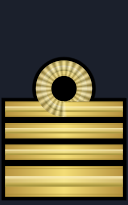 The English word “command” was originally synonymous with “commend,” as in “I commend to your care,” or “I commend your courage.” So “command” actually has the sense of entrusting, and of praising what is worthy. Its root is the same as “mandate,” and comes from two Latin words, “man” which means “hand,” and “dare” which means “to give.” “Command” means to give into worthy hands, to entrust a duty to a worthy person.
The English word “command” was originally synonymous with “commend,” as in “I commend to your care,” or “I commend your courage.” So “command” actually has the sense of entrusting, and of praising what is worthy. Its root is the same as “mandate,” and comes from two Latin words, “man” which means “hand,” and “dare” which means “to give.” “Command” means to give into worthy hands, to entrust a duty to a worthy person.
Here’s an example.
When I sailed as chief mate on the 145′ tall ship CALIFORNIAN, Captain Andy Reay-Ellers would sometimes issue commands with his ball cap. This simple gesture transformed my understanding of command.
Most of the time Captain Andy got us ready to tack the ship (a complicated maneuver for turning a traditional sailing ship that requires the crew to handle all the ship’s sails, releasing them on one side of the ship and pulling them in on the other, in the right order, with the right timing and in a hurry as the ship turns) by calling out the initial command of “Ready about.” Then it was my job to organize the crew for the various tasks. There was a fair bit of shouting across the deck directing each person, and I believed that the smoothness and efficiency of the operation relied on my voice. The crew had learned to believe this too. They were all listening to me. But we learned a more elegant and effective way from Andy’s cap.
We often had a crowd of tourists on board for a day sail, serving drinks and refreshments on deck, and the crew were expected to mingle with the guests to answer questions and tell our sea tales. In this context of hosting a party, my shouting over the heads of the passengers may have been nicely salty, but it wasn’t very elegant.
So Andy taught us all to keep an eye on his ball cap as we mingled. When it was time to tack he would turn the brim of the cap to the side over one ear. This was “Ready about.” One of the crew would notice, and excuse themselves from their conversations with the guests and move to position at a sail. Others of us would notice the first person moving and move too, and our noticing rippled among us until everyone was in place. No need for me to tell them where to go, they knew the job and if a station were already covered they’d go to another. When I could see that we were all in position I’d signal Andy and he’d turn his ball cap backwards, as the command to tack. I gave no directions for individual tasks, and the crew found their own rhythm, watching and synchronizing with each other. If something wasn’t right I could correct it as we went.
This is the difference between “command and control” and “command and trust.”
Giving command requires us to be careful of what we give. When I felt I had to hold the smoothness and efficiency of tacking the ship myself, by giving directions for every step, I reduced the crew to just doing what I said, and I reduced their sense of their own worthiness too. With those shouted directions I gave dependence and myopia. What Andy gave with his ball cap was broad awareness, initiative and shared responsibility. And real trust; the qualities that make any ship, or business, or family, run well. If something wasn’t right, I could see and correct it more easily undistracted by my own shouting.
Both approaches tacked the ship, but the silent ball cap was a better commander than my shouting. Command is a generosity practice, and its goal is to bring out the worthiness in everyone. Then the best outcome follows easily.


